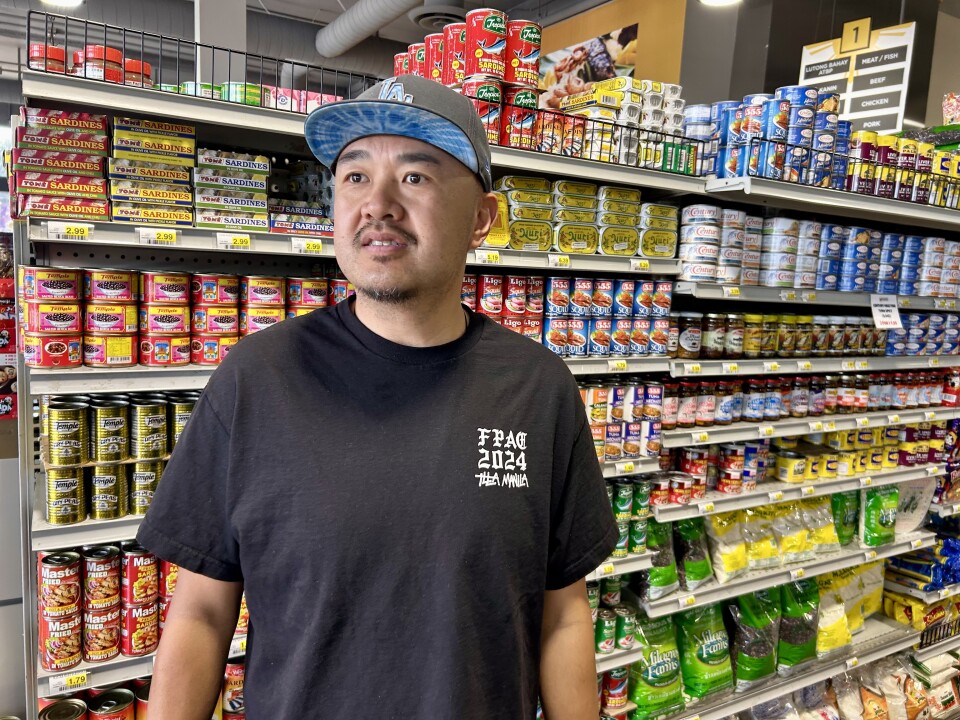Truth matters. Community matters. Your support makes both possible. LAist is one of the few places where news remains independent and free from political and corporate influence. Stand up for truth and for LAist. Make your year-end tax-deductible gift now.
Looking beyond LA's Historic Filipinotown: The Valley Has a thriving Filipino community too

The intersection of Roscoe Boulevard and Woodman Avenue in the San Fernando Valley has dense traffic, two strip malls, a hospital and a gas station. But it’s much more than that to people who know what this area looked like a century ago: large swaths of citrus trees and wheat fields on farms that needed people to work the land.
“By the [1920s and 1930s] Filipinos started to come because a lot of agricultural interests wanted cheaper labor… and the 1924 Immigration Act just closed the borders for a lot of immigrants,” said historian Joseph Bernardo, author of the new book Filipinos in the San Fernando Valley.
But the act didn't apply to Filipinos because the Philippines was a U.S. colony. So many came to find work.

“There was a small community [of Filipinos] that settled in the Pacoima-San Fernando area, where a majority of people of color were allowed to live in,” Bernardo said.
But for most of the 20th century, housing restrictions kept people who were not white from buying homes in the San Fernando Valley. That changed in the 1970s, which led many Filipinos to move from dense neighborhoods in and around downtown L.A. to larger homes in the valley.
A Filipino suburbia
There are now about 80,000 people of Philippine descent in the valley. While there are better known Filipino communities, such as those in and around L.A.'s historic Filipinotown just west of downtown L.A., as well as the communities in Carson, and Cerritos, Bernardo wants to make sure the valley isn’t overlooked.

“Most Filipinos who live in the United States now live in suburban neighborhoods and suburban communities,” said Bernardo, and the book’s text and plentiful photos show the transitions in the valley. “When suburbia was mostly white and when people of color started moving to suburbia in greater numbers during the 70s, 80s, 90s.”

Filipinos in the San Fernando Valley is part of a long-running series by Arcadia Publishing that highlights the history of Southern California communities, like how Filipinos were part of the valley’s suburban boom after World War II.

Bernardo and his family were part of that history. His parents came to the U.S. from the Philippines in 1973. He grew up in Northridge, a few miles west of Roscoe and Woodman. There were few Filipinos in the valley when he was growing up.

“Sometimes when I drive around, I think about what it was like when Filipino immigrants started to come here and purchase homes in Panorama City and how white the neighborhood used to be,” Bernardo said.
The next generation of Filipinos in the valley
That’s changed a lot. The vast majority of residents in Panorama City, a neighborhood in the city of L.A., are Latino now, he said, but it’s about 15% Filipino, which makes it a strong enclave. The sole Filipino-American representative on the L.A. City Council, Ysabel Jurado, however, represents the downtown L.A.-Boyle Heights area.
“There's a lot of political representation that is needed here in the valley for the Filipino community,” Bernardo said.
That’s important, because, he said, there are many recent immigrants and blue collar Filipino Americans who are struggling, with wage theft issues in the workplace, and teens needing help navigating the college pipeline.
Bernardo said there’s a new generation of Gen Z Filipinos, some working out of Panorama City, who are filling that gap and helping their community by joining organizations like Migrante SFV and Anakbayan Panorama City.

“I've seen more momentum with this generation than 20, 25 years ago when I was in my twenties,” he said.
There's a lot of political representation that is needed here in the valley for the Filipino community.
Bernardo said these activists are tapping into a long history of Filipinos and social justice activism. That history includes Filipinos playing important parts in the founding of the United Farm Workers, and California student activism in the 1980s.
Lecture details
Bernardo is scheduled to talk about these topics in Long Beach for a Filipino literary festival as part of Filipino American History month celebrations.
Location: Michelle Obama Neighborhood Library, 5870 Atlantic Ave., Long Beach
Date / time: Oct. 25, 11:00 a.m. to 5 p.m.








